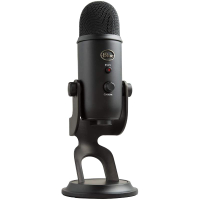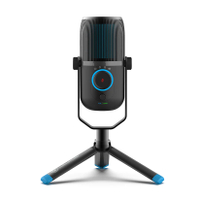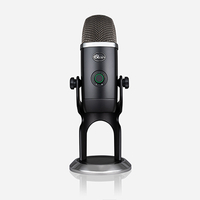In other words, anyone can give themselves a dramatic boost to how they sound in remote meetings and social chats, granting even better clarity than the best headsets and headphones for working from home. But which should you buy? Our list of the best USB microphones we’ve tested can answer that.
The best USB microphones you can buy right now
The Blue Yeti is one of audio tech’s timeless classics: a USB microphone that’s good at just about everything, and bad at pretty much nothing. Other than a relatively inflexible stand there’s everything a home recorder could want here, from excellent recording quality to a sturdy (but not too bulky) design. If you like you can just plug in and start using it in cardioid mode, but the Yeti’s versatile mix of recording patterns also makes it viable for recording a group. Bidirectional mode records both in front of and behind the mic, for example, while the omnidirectional mode records in a full 360-degree radius. Read our full Blue Yeti review. Despite JLab’s relative lack of experience with dedicated mics, it’s put out a stellar USB microphone in the Talk. This affordable, tripod-mounted number has the same set of recording patterns as the Blue Yeti, and is roughly a match for it on the clarity and warmth of its recordings. Some may find the JLab Talk even better, as its tripod base is more adjustable than the Yeti’s fixed stand. We also like how the gain and headphone volume controls use a large light-up ring to indicate current levels, so it’s easy to tell at a glance what your current settings are. Lesser mics don’t always make these details clear. Read our full JLab Talk review. Blue has yet another top-notch USB microphone in the Yeti X. As the name suggests, it’s basically a souped-up Blue Yeti, with a similar overall design and high standards of recording quality. That goes for a range of supported directional patterns, too. It does cost more, in exchange for a handful of design improvements: the gain switch is positioned on the front, for easier access, and a ring of LEDs can keep you informed on how loud you are in real time; a handy alternative to using headphones for monitoring. We’d still say the standard Blue Yeti is the better deal, especially for casual users, but the Blue Yeti X is a fine USB mic. Read our full Blue Yeti X review. Not unlike the JLab Talk, the Movo UM700 aims to put category-leading sound quality into a somewhat more affordable package, without sacrificing build quality or utility. In fact, it was originally pitched to us as a “Blue Yeti killer.” The Yeti is clearly still breathing, but the UM700 can put up a decent fight. It’s sturdy and, as per usual with the best USB mics, works easily as soon as you plug it in. Its recording capabilities held up well in testing too, even if some periodic gain adjustments were necessary. Happily, you can do this with the onboard controls, without the need for separate software. Read our full Movo UM700 review. Yes, another one. Whereas the Blue Yeti X is a more refined take on the microphone at the top of this list, the Yeti Nano is an attempt to make it simpler, cheaper and more portable. All without dropping into the outright budget territory already occupied by the Snowball Ice. The result is a microphone that sounds crisp and takes up less space on your desk, while maintaining the elegant ease of use that Blue mics are loved for. The Yeti Nano does drop bidirectional and stereo recording modes, so it’s not as versatile as the similarly-priced JLab Talk, but since you only need cardioid for directional recording, this remains a good pick for calls or the odd spot of gaming. Read our full Blue Yeti Nano review. The Wave: 3 is one of the pricier cardioid-only models we’ve tested, but it’s one of the best USB microphones for a reason. It sounds great, has easy-to-use controls and even looks rather handsome, what with its slim sideways profile and steel grille. It’s also cheaper than the EPOS B20, another streaming-focused mic. Its real strength, though, lies in its bonus features for streaming. It’s designed to closely integrate with Elgato’s Stream Deck, a 16-button keypad that can control all manner of functions while you’re in a middle of a stream. This can include the Wave: 3, so you can adjust your mic input properties with just a few simple button presses. Non-streamers can look elsewhere, but this is one of the best specialized USB mics we’ve seen. Read our full Elgato Wave: 3 review. We’re fans of the standard HyperX QuadCast, and the QuadCast S model ups its game by adding customizable RGB lighting around the grille. Gamers and streamers in particular might appreciate this extra touch of flashiness — after all, who says a USB device can’t look interesting? Clean, clear recording quality also ensures that the QuadCast S isn’t just a shiny bauble, and the built-in shock mount and pop filter help out too. If you’re willing to spend a little more for some hardware extras, the QuadCast S has you covered. A full set of cardioid, bidirectional, omnidirectional and stereo modes are on hand too, though once again this doesn’t overcomplicate things if you just want to pop in the USB cable and go. Read our full HyperX QuadCast S review.
How to choose the best USB microphone for you
Price All of the best USB microphones have broadly similar form factors and, of course, connectivity. As such the first thing you may wish to consider is price: do you try to stick with a cheap $50 model, or spend over $100 for a more fully-featured model? In truth, $100-150 is still relatively low by dedicated microphone standards, and you can get several rich-sounding mics in this price range alone. It’s fine to shop cheaper, though, if you only want a USB microphone for merely occasional use. Sound quality None of the mics on this list sound bad, or else they wouldn’t be here. But it’s natural to want want the highest recording quality that your budget allows for, which is probably why the Blue Yeti remains so popular. Integrated pop filters can help silence distracting popping sounds when you’re speaking close to the grille, but these aren’t essential for high sound quality. It’s more important to make sure you have the microphone angled correctly while you’re using it. Recording patterns If you’re only going to be recording yourself, any mic that uses a cardioid recording pattern is fine; this just means the mic only records the area in front of it, i.e. a single user. If you want to dabble in making podcasts or anything else that requires recording multiple speakers at once, bidirectional and omnidirectional capabilities are a must. Some USB microphones also have a stereo mode, which isn’t much better than cardioid for individual speech, but can be good for recording music. Panel discussions also lend themselves well to stereo recording, as you’ll get an idea of where each speaker was positioned when you listen back.
How we test the best USB microphones
To test USB microphones, we’ll record ourselves speaking into them and play back those recordings to hear how they sound with different settings. Fortunately, most models keep these simple, but tweaking the controls that are available and re-recording also lets us judge both how user-friendly these mics are and how easy it is to find the ideal gain, volume and positioning for them. Naturally we’ll repeat the process if a USB mic supports different recording patterns. We can test bidirectional and omnidirectional modes just by speaking into the microphone from different angles, but sometimes we can put them through the ultimate test with a live podcast recording. Alternatively, we’ll use a mic for voice and video calls, and ask other members of the call how we sound. We rate all our microphone reviews on a 5-point system (1 = worst, 5 = best). Products that excel in one or more particular fields and that’s rated 4 stars or above may also receive an Editor’s Choice award. Contributions from James Archer Next: Get your home studio started with other audio hardware essentials we’ve tested, including the best podcasting microphones, best headphones, best laptops, best webcams and best computer speakers.

















title: “The Best Usb Microphones In 2022” ShowToc: true date: “2022-12-16” author: “Carl Morrissette”
In other words, anyone can give themselves a dramatic boost to how they sound in remote meetings and social chats, granting even better clarity than the best headsets and headphones for working from home. But which should you buy? Our list of the best USB microphones we’ve tested can answer that.
The best USB microphones you can buy right now
The Blue Yeti is one of audio tech’s timeless classics: a USB microphone that’s good at just about everything, and bad at pretty much nothing. Other than a relatively inflexible stand there’s everything a home recorder could want here, from excellent recording quality to a sturdy (but not too bulky) design. If you like you can just plug in and start using it in cardioid mode, but the Yeti’s versatile mix of recording patterns also makes it viable for recording a group. Bidirectional mode records both in front of and behind the mic, for example, while the omnidirectional mode records in a full 360-degree radius. Read our full Blue Yeti review. Despite JLab’s relative lack of experience with dedicated mics, it’s put out a stellar USB microphone in the Talk. This affordable, tripod-mounted number has the same set of recording patterns as the Blue Yeti, and is roughly a match for it on the clarity and warmth of its recordings. Some may find the JLab Talk even better, as its tripod base is more adjustable than the Yeti’s fixed stand. We also like how the gain and headphone volume controls use a large light-up ring to indicate current levels, so it’s easy to tell at a glance what your current settings are. Lesser mics don’t always make these details clear. Read our full JLab Talk review. Blue has yet another top-notch USB microphone in the Yeti X. As the name suggests, it’s basically a souped-up Blue Yeti, with a similar overall design and high standards of recording quality. That goes for a range of supported directional patterns, too. It does cost more, in exchange for a handful of design improvements: the gain switch is positioned on the front, for easier access, and a ring of LEDs can keep you informed on how loud you are in real time; a handy alternative to using headphones for monitoring. We’d still say the standard Blue Yeti is the better deal, especially for casual users, but the Blue Yeti X is a fine USB mic. Read our full Blue Yeti X review. Not unlike the JLab Talk, the Movo UM700 aims to put category-leading sound quality into a somewhat more affordable package, without sacrificing build quality or utility. In fact, it was originally pitched to us as a “Blue Yeti killer.” The Yeti is clearly still breathing, but the UM700 can put up a decent fight. It’s sturdy and, as per usual with the best USB mics, works easily as soon as you plug it in. Its recording capabilities held up well in testing too, even if some periodic gain adjustments were necessary. Happily, you can do this with the onboard controls, without the need for separate software. Read our full Movo UM700 review. Yes, another one. Whereas the Blue Yeti X is a more refined take on the microphone at the top of this list, the Yeti Nano is an attempt to make it simpler, cheaper and more portable. All without dropping into the outright budget territory already occupied by the Snowball Ice. The result is a microphone that sounds crisp and takes up less space on your desk, while maintaining the elegant ease of use that Blue mics are loved for. The Yeti Nano does drop bidirectional and stereo recording modes, so it’s not as versatile as the similarly-priced JLab Talk, but since you only need cardioid for directional recording, this remains a good pick for calls or the odd spot of gaming. Read our full Blue Yeti Nano review. The Wave: 3 is one of the pricier cardioid-only models we’ve tested, but it’s one of the best USB microphones for a reason. It sounds great, has easy-to-use controls and even looks rather handsome, what with its slim sideways profile and steel grille. It’s also cheaper than the EPOS B20, another streaming-focused mic. Its real strength, though, lies in its bonus features for streaming. It’s designed to closely integrate with Elgato’s Stream Deck, a 16-button keypad that can control all manner of functions while you’re in a middle of a stream. This can include the Wave: 3, so you can adjust your mic input properties with just a few simple button presses. Non-streamers can look elsewhere, but this is one of the best specialized USB mics we’ve seen. Read our full Elgato Wave: 3 review. We’re fans of the standard HyperX QuadCast, and the QuadCast S model ups its game by adding customizable RGB lighting around the grille. Gamers and streamers in particular might appreciate this extra touch of flashiness — after all, who says a USB device can’t look interesting? Clean, clear recording quality also ensures that the QuadCast S isn’t just a shiny bauble, and the built-in shock mount and pop filter help out too. If you’re willing to spend a little more for some hardware extras, the QuadCast S has you covered. A full set of cardioid, bidirectional, omnidirectional and stereo modes are on hand too, though once again this doesn’t overcomplicate things if you just want to pop in the USB cable and go. Read our full HyperX QuadCast S review.
How to choose the best USB microphone for you
Price All of the best USB microphones have broadly similar form factors and, of course, connectivity. As such the first thing you may wish to consider is price: do you try to stick with a cheap $50 model, or spend over $100 for a more fully-featured model? In truth, $100-150 is still relatively low by dedicated microphone standards, and you can get several rich-sounding mics in this price range alone. It’s fine to shop cheaper, though, if you only want a USB microphone for merely occasional use. Sound quality None of the mics on this list sound bad, or else they wouldn’t be here. But it’s natural to want want the highest recording quality that your budget allows for, which is probably why the Blue Yeti remains so popular. Integrated pop filters can help silence distracting popping sounds when you’re speaking close to the grille, but these aren’t essential for high sound quality. It’s more important to make sure you have the microphone angled correctly while you’re using it. Recording patterns If you’re only going to be recording yourself, any mic that uses a cardioid recording pattern is fine; this just means the mic only records the area in front of it, i.e. a single user. If you want to dabble in making podcasts or anything else that requires recording multiple speakers at once, bidirectional and omnidirectional capabilities are a must. Some USB microphones also have a stereo mode, which isn’t much better than cardioid for individual speech, but can be good for recording music. Panel discussions also lend themselves well to stereo recording, as you’ll get an idea of where each speaker was positioned when you listen back.
How we test the best USB microphones
To test USB microphones, we’ll record ourselves speaking into them and play back those recordings to hear how they sound with different settings. Fortunately, most models keep these simple, but tweaking the controls that are available and re-recording also lets us judge both how user-friendly these mics are and how easy it is to find the ideal gain, volume and positioning for them. Naturally we’ll repeat the process if a USB mic supports different recording patterns. We can test bidirectional and omnidirectional modes just by speaking into the microphone from different angles, but sometimes we can put them through the ultimate test with a live podcast recording. Alternatively, we’ll use a mic for voice and video calls, and ask other members of the call how we sound. We rate all our microphone reviews on a 5-point system (1 = worst, 5 = best). Products that excel in one or more particular fields and that’s rated 4 stars or above may also receive an Editor’s Choice award. Contributions from James Archer Next: Get your home studio started with other audio hardware essentials we’ve tested, including the best podcasting microphones, best headphones, best laptops, best webcams and best computer speakers.
















